As a parent, you want to ensure that your little one is safe and comfortable in their crib.
However, you may be wondering just how much weight can a crib hold? Well, we have good news for you! In this blog post, we’ll answer this pressing question so that you can have peace of mind knowing that your baby’s crib is safe and secure.
The amount of weight a crib can hold varies depending on the specific model and manufacturer, but most cribs are designed to hold a minimum of 50 pounds. However, it’s important to note that weight limits can change as your child grows and becomes more active, so it’s essential to always follow the manufacturer’s guidelines and regularly check the crib’s stability.
In this post, we’ll dive deeper into the different factors that can affect a crib’s weight limit, such as materials, design, and construction.
We’ll also provide some useful tips on how to maintain your baby’s crib to ensure its longevity and safety.
So, if you’re a new parent or just curious about crib weight limits, keep reading to learn more!
What Is a Crib Anyways?
Congratulations on your new arrival!
As a new parent, you’ll want to make sure that your baby is safe and comfortable, especially during sleep.
One important piece of furniture to consider for your little one is a crib.
A crib is a bed designed specifically for infants and toddlers, providing a safe and secure environment for them to sleep.
Cribs come in different sizes and styles, but they all share the same basic structure of a headboard, footboard, and adjustable side rails that enclose the mattress.
The mattress support can usually be adjusted to different heights as your baby grows, and most cribs come with lockable casters that make it easy to move the crib around the room.
There are several reasons why you should consider a crib for your newborn.
First and foremost, cribs provide a safe sleeping environment for your baby. They are designed to meet safety standards, such as having slats that are spaced no more than 2 3/8 inches apart to prevent your baby’s head from getting stuck.
A properly installed crib can also prevent your baby from rolling out of bed, which can be dangerous and cause injury.
Cribs are also designed to be comfortable for your baby, with a firm mattress that supports their growing body.
By providing a consistent sleeping environment, a crib can help establish healthy sleeping habits for your baby, which is crucial for their physical and emotional development.
Additionally, cribs can be a convenient addition to your home, as they allow your baby to have their own designated sleeping area.
This can help promote a sense of security and routine for your baby, which is beneficial for their development.
It provides a safe and comfortable sleeping environment for your baby, while also establishing healthy sleeping habits and promoting a sense of security.
Make sure to choose a crib that meets safety standards and follow the manufacturer’s instructions for proper installation.
Congratulations again on your new addition, and I wish you and your baby a good night’s sleep!
Basic Crib Structure
The structure of a crib is composed of several parts, each of which plays a critical role in the crib’s stability and safety.
Headboard and Footboard
The headboard and footboard are the two main ends of the crib, and they’re typically designed to be larger and more decorative than the side rails.
These parts are made of sturdy materials like wood, metal, or plastic and are responsible for providing stability and support to the crib.
Side Rails
The side rails are the long, vertical panels that connect the headboard and footboard, enclosing the crib on all sides. These rails are typically adjustable, allowing for customization of the crib’s size as the child grows.
The side rails should be sturdy enough to prevent the baby from falling out but also spaced enough to allow for adequate ventilation.
Mattress Support
The mattress support is the platform where the baby’s mattress sits.
It’s typically made of metal or wood and is designed to provide a stable and secure foundation for the mattress.
The support should be adjustable to accommodate different mattress heights and should be firmly attached to the side rails to prevent it from collapsing.
Mattress
The mattress is part of the crib that the baby directly interacts with, providing them with a comfortable sleeping surface.
Mattresses can be made of various materials, including foam, innerspring, and organic materials.
It’s important to choose a mattress that fits snugly in the crib and is firm enough to prevent suffocation or Sudden Infant Death Syndrome (SIDS).
Casters
Many cribs come with wheels or casters that allow the crib to be easily moved from one location to another.
However, it’s crucial to ensure that the casters are lockable to prevent the crib from accidentally rolling away when in use.
Hardware
Finally, the hardware is the collection of screws, bolts, and other fasteners that hold the crib together.
These parts are essential for the crib’s stability and safety, and it’s essential to follow the manufacturer’s instructions for assembly to ensure proper installation and prevent any accidents.
In conclusion, the parts of a crib’s structure are critical to the safety and functionality of the crib.
It’s essential to choose a crib that meets all safety standards and to regularly inspect the crib for any signs of wear and tear that may compromise its stability.
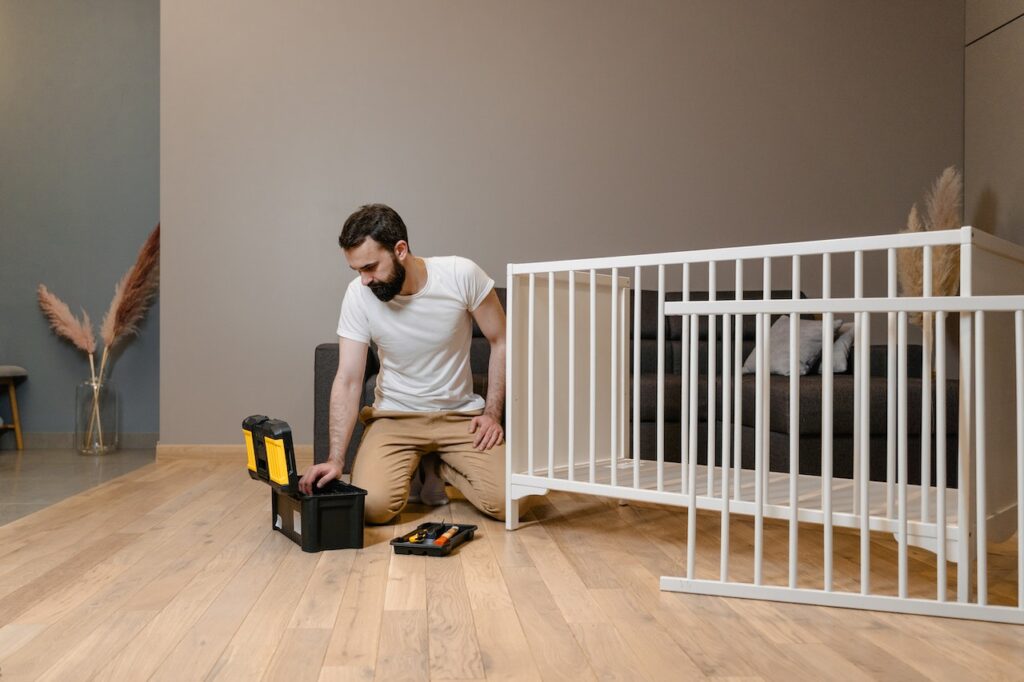
co-sleeping Issues
Co-sleeping, or sharing a bed with your baby, is a common practice in many cultures and has become more popular in recent years.
While co-sleeping can be a way to bond with your baby and make breastfeeding easier, it’s important to understand the potential risks and to take precautions to keep your baby safe.
The American Academy of Pediatrics (AAP) recommends that babies sleep in their own crib or bassinet for the first six months of life, and ideally for the first year. This AAP article goes into 2022 sleeping guideline updates that reiterate discouraging bedsharing. This is because co-sleeping can increase the risk of suffocation, entrapment, and sudden infant death syndrome (SIDS).
If you do choose to co-sleep with your baby, there are several precautions you can take to make it safer. These include:
- Avoid co-sleeping on a soft surface, such as a waterbed, couch, or armchair. Instead, use a firm mattress on a stable surface.
- Keep your baby on their back to reduce the risk of SIDS.
- Make sure there are no gaps or spaces between the mattress and the bed frame or wall where your baby could become trapped.
- Avoid using pillows, blankets, or other soft objects in the bed that could cover your baby’s face.
- Avoid co-sleeping if you or your partner smoke, are under the influence of drugs or alcohol, or are excessively tired.
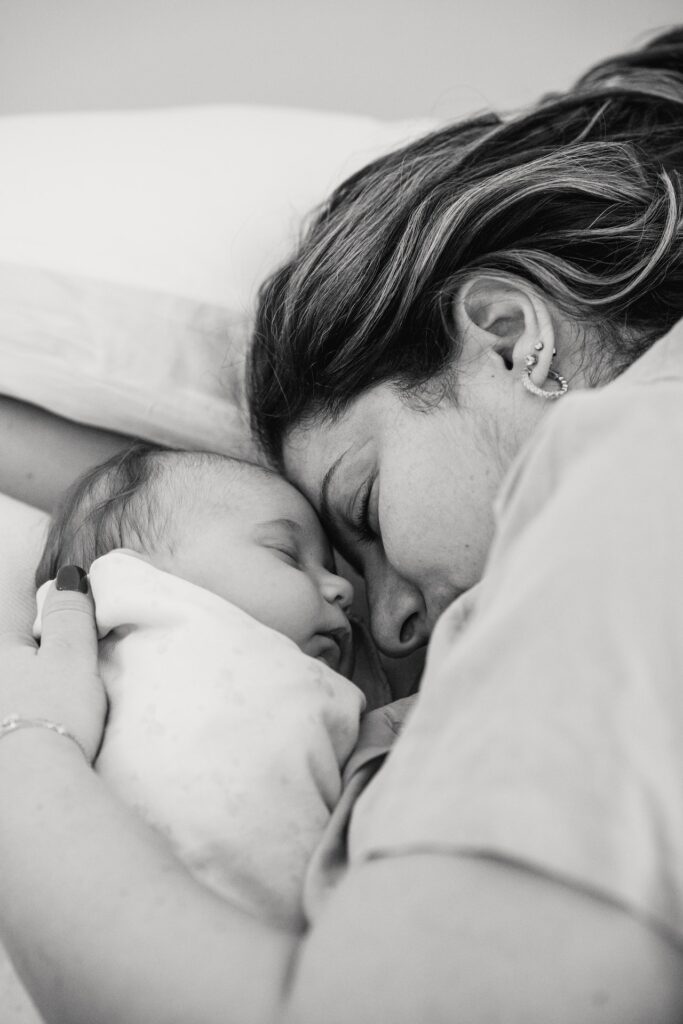
It’s important to note again that co-sleeping in a crib is not recommended.
While some cribs may have weight limits that allow for adult use, it’s important to remember that cribs are not designed for adult use and could be dangerous if weight limits are exceeded.
Additionally, the AAP recommends against using crib bumpers or other accessories that could increase the risk of suffocation or entrapment.
Maximum Capacities
When it comes to choosing a crib or mini crib for your baby, one important factor to consider is its weight capacity.
Every crib and mini crib has a maximum weight capacity, which indicates the maximum weight that the product can safely support.
Here’s what you need to know about the weight capacities of cribs and mini cribs.
Full-size cribs typically have a weight capacity of 50 pounds or more.
This means that they can accommodate most babies and toddlers, and often have adjustable mattress heights to accommodate your growing child.
However, it’s important to keep in mind that as your child gets older and more active, they may start to jump and play in their crib, which can put additional stress on the structure.
To ensure the safety of your child, it’s important to follow the manufacturer’s guidelines and only use the crib for its intended purpose.
Mini cribs, on the other hand, typically have a lower weight capacity than full-size cribs.
Most mini cribs can safely support up to 50 pounds, but some may have a lower weight limit.
This is because mini cribs are designed for smaller spaces and may have a smaller footprint and lighter weight than full-size cribs.
Mini cribs can be a good choice for parents who want a portable, space-saving option or for those who plan to use the crib for a shorter period of time.
Are convertible cribs worth it?
Convertible cribs are a popular choice for parents looking to save money and get more use out of their baby furniture.
These cribs are designed to grow with your child, so they can be converted into a toddler bed, daybed, or even a full-size bed as your child gets older.
One of the main benefits of a convertible crib is its financial value. While the upfront cost of a convertible crib may be higher than a standard crib, it can ultimately save you money in the long run.
Rather than having to purchase a separate toddler bed or full-size bed when your child outgrows their crib, a convertible crib can be easily transformed into the next stage of their sleeping arrangement. This can help you save money on additional furniture and keep your child’s bedroom looking cohesive.
In addition to the financial benefits, convertible cribs are also versatile and offer more use as your child grows older.
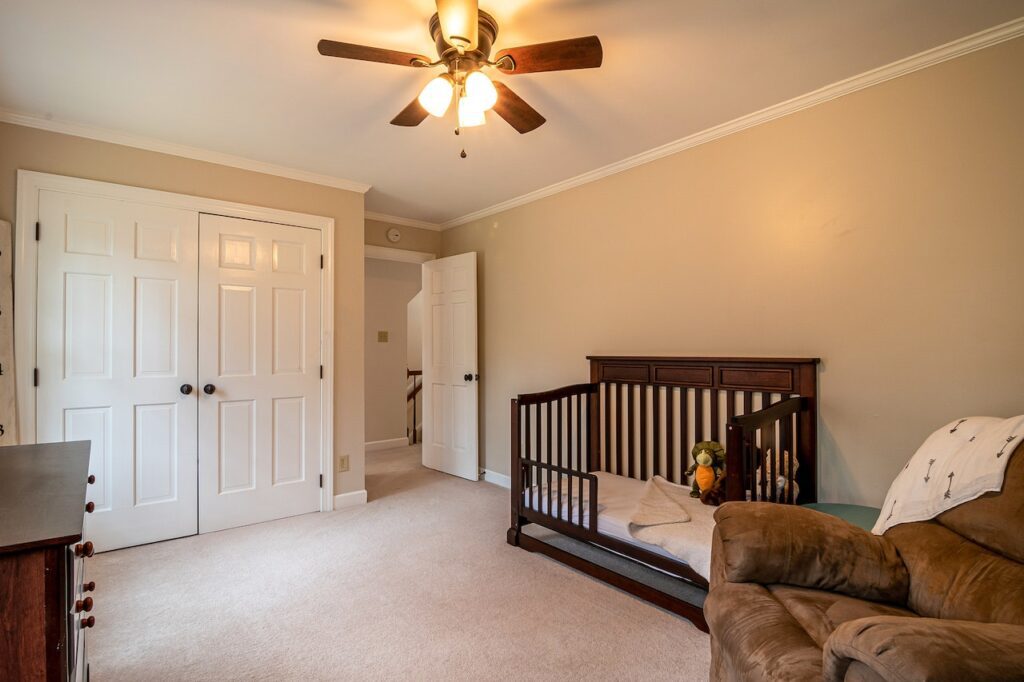
When your child is ready to transition to a toddler bed, you can simply remove one of the crib rails to create a safe and secure sleeping space. As your child gets older, you can also remove the toddler bed rail and convert the crib into a daybed, which can be a great place for your child to read or play.
Finally, when your child is ready for a full-size bed, many convertible cribs can be converted with a conversion kit, which can be purchased separately.
It’s important to note that not all convertible cribs are created equal, so it’s important to do your research and choose a high-quality product from a reputable manufacturer. Look for cribs that meet safety standards, have sturdy construction, and come with clear instructions for assembly and use.
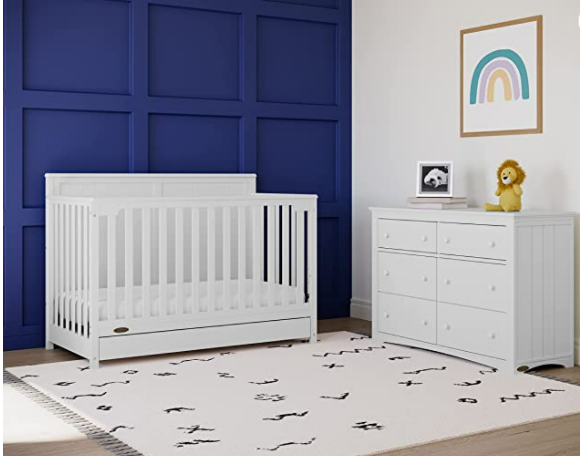
For example, this crib is great because it’s a 5-in-1 (converts from baby crib to toddler bed, daybed, and full-size bed with headboard & optional footboard (conversion kit sold separately), has underbed storage built in and is JPMA certified and safety tested. You can check the price on Amazon. When I looked it was 20% off at around $260.
When Do Babies Outgrow Their Cribs?
Babies grow up quickly, and before you know it, they may start to outgrow their crib.
While there is no set age when a child should move out of their crib, there are a few signs that can indicate that it’s time to start thinking about a transition.
- One of the most obvious signs that your child has outgrown their crib is when they start to climb out of it. This can be a dangerous situation, as your child may fall and injure themselves. If your child is able to climb out of their crib, it’s definitely time to start considering other sleeping arrangements.
- Another sign that your child has outgrown their crib is if they are visibly uncomfortable or cramped when they sleep. If your child is unable to stretch out fully in their crib or if they are hitting the sides of the crib with their arms or legs, it may be time to consider a larger sleeping option.
- Finally, if your child is getting too tall or too heavy for their crib, it’s time to start thinking about a transition. Most cribs have weight limits and size restrictions, so if your child is approaching these limits, it may be time to consider a larger bed.
When your child outgrows their crib, you have several options for the next stage of their sleeping arrangement. You can choose to move them to a toddler bed, which is a low-to-the-ground bed that is designed for young children. Toddler beds often feature safety rails to prevent falls and can be a good choice for children who are not quite ready for a larger bed.
Another option is to move your child straight to a twin or full-size bed, depending on their size and age. These larger beds can provide more space and may be a good choice for older children who are ready for a bigger sleeping option.
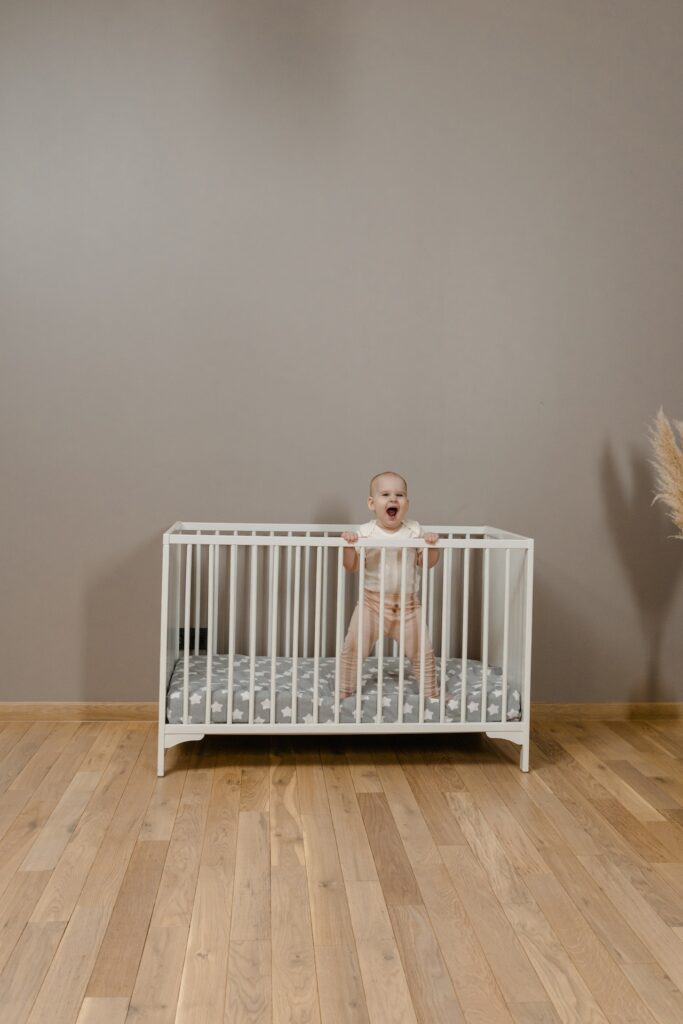
Why It’s Important To Follow The Weight Limit
Crib weight limits are put in place to ensure the safety of your child while they sleep. It’s important to follow these limits to prevent the risk of the crib breaking or collapsing, which can lead to serious injury or even death. (You should also read my post on how to safely decorate above baby’s crib.)
If you don’t follow the weight limits on a crib, you run the risk of the crib breaking or collapsing, which can cause serious harm to your child. The crib slats or mattress support can bend or even break under the weight of a child who is too heavy for the crib, leading to a dangerous situation.
The structural integrity of the crib is also compromised when it is overloaded, and it may not be able to support your child’s weight or movement, making it more likely to tip or collapse.
Additionally, not following the weight limits of a crib may also void the manufacturer’s warranty or insurance policies. If the crib is damaged due to excessive weight, you may not be able to return or exchange it for a replacement, leaving you with a potentially dangerous and unusable crib.
It’s important to note that weight limits apply not only to your child, but also to any additional items placed in the crib, such as toys, blankets, or stuffed animals.
These items can add extra weight to the crib and increase the risk of the crib collapsing or tipping over.
FAQs
Can I fit in my baby’s crib?
It’s unlikely that an adult can fit in a standard baby crib, as they are designed for infants and have weight and size limits. Attempting to fit in the crib can also be dangerous and can damage the structure of the crib, potentially putting your baby at risk.
Can a baby sleep in a playard instead of a crib?
Yes, a playard can be a safe and convenient alternative to a crib for newborns and young infants. Many playards are designed with a bassinet insert that can be used for newborns, and they often have weight and size limits that are appropriate for young children.
Why does my baby cry when I put them in their crib?
Babies may cry when placed in their crib for several reasons, such as separation anxiety, fear of the dark, hunger, or discomfort.
It’s important to try and identify the cause of your baby’s crying and address it appropriately, whether it’s by offering a feeding or diaper change, providing a comforting object or sound, or slowly transitioning your baby to sleeping independently in their crib.
How long should you let a baby cry when you put them down?
There is no set amount of time that you should let a baby cry when you put them down, as every baby is different. Some babies may settle down quickly, while others may take longer to fall asleep.
It’s important to monitor your baby’s crying and make sure that they are safe and comfortable, and to respond appropriately to their needs. Some experts recommend using a sleep training method, such as the Ferber method, which involves gradually increasing the amount of time you wait before checking on your baby, to help establish healthy sleep habits.
However, it’s important to discuss any sleep training methods with your pediatrician and ensure that they are appropriate for your baby’s age and development.
Should my crib be GREENGUARD Gold certified?
There’s definitely peace of mind knowing that your baby isn’t breathing in chemicals like volatile organic compounds all night as they sleep. While there are multiple types of certifications, GREENGUARD is pretty stringent. Find out more at this post where you can learn all about it.
pssst…If you found this post helpful, check out my post on whether stroller wagons are really worth it (hint, um yes indeed).

